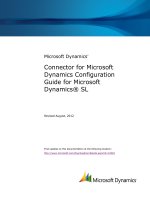Microsoft dynamics NAV 2015 professional reporting
Bạn đang xem bản rút gọn của tài liệu. Xem và tải ngay bản đầy đủ của tài liệu tại đây (21.85 MB, 504 trang )
[1]
www.allitebooks.com
Microsoft Dynamics NAV 2015
Professional Reporting
Discover tips and tricks for Dynamics NAV
report building
Steven Renders
BIRMINGHAM - MUMBAI
www.allitebooks.com
Microsoft Dynamics NAV 2015 Professional Reporting
Copyright © 2015 Packt Publishing
All rights reserved. No part of this book may be reproduced, stored in a retrieval
system, or transmitted in any form or by any means, without the prior written
permission of the publisher, except in the case of brief quotations embedded in
critical articles or reviews.
Every effort has been made in the preparation of this book to ensure the accuracy
of the information presented. However, the information contained in this book is
sold without warranty, either express or implied. Neither the author, nor Packt
Publishing, and its dealers and distributors will be held liable for any damages
caused or alleged to be caused directly or indirectly by this book.
Packt Publishing has endeavored to provide trademark information about all of the
companies and products mentioned in this book by the appropriate use of capitals.
However, Packt Publishing cannot guarantee the accuracy of this information.
First published: September 2015
Production reference: 1110915
Published by Packt Publishing Ltd.
Livery Place
35 Livery Street
Birmingham B3 2PB, UK.
ISBN 978-1-78528-473-1
www.packtpub.com
www.allitebooks.com
Credits
Author
Copy Editors
Steven Renders
Kevin McGowan
Rashmi Sawant
Reviewers
Daniela Bozdoc
Project Coordinator
Alex Chow
Sanjeet Rao
Daniel Rimmelzwaan
Proofreader
Matt Traxinger
Safis Editing
Commissioning Editor
Dipika Gaonkar
Indexer
Priya Sane
Acquisition Editors
Purav Motiwalla
Richard Brookes-Bland
Content Development Editor
Shweta Pant
Graphics
Abhinash Sahu
Production Coordinator
Nitesh Thakur
Cover Work
Technical Editor
Saurabh Malhotra
Nitesh Thakur
www.allitebooks.com
About the Author
Steven Renders is a Microsoft Certified Trainer with skills that span the business
and technical domains. He specializes in Microsoft Dynamics NAV and Microsoft
SQL Server. He has more than 15 years of both business and technical experience.
He provides training and consultancy that focuses on Microsoft Dynamics NAV,
Microsoft SQL Server, business intelligence solutions, Microsoft SQL Server
Reporting Services, and database performance tuning.
Furthermore, he is also an expert in Microsoft Dynamics NAV, on which he has
already delivered many training sessions. He was also the author of the official
Microsoft training material on Dynamics NAV reporting, development,
upgrading, and SQL Server performance tuning.
He is the author of the books, Microsoft Dynamics NAV 2015 Professional Reporting
and Microsoft Dynamics NAV 2009: Professional Reporting and also a reviewer of the
books, Programming Microsoft Dynamics NAV 2009, Programming Microsoft Dynamics®
NAV 2013, and Implementing Microsoft Dynamics NAV 2013.
He has also presented at various Microsoft MSDN and TechNet conferences, NAV
Techdays, communities, events, and the MCT Summit.
In 2011, he started his own company, think about IT, which specializes in training
and consultancy, helping companies learn, implement, understand, and solve
complex business requirements related to IT, both in Belgium and abroad.
His specialties are Microsoft Dynamics NAV, Microsoft SQL Server, Business
Intelligence & Reporting, and Power BI.
You can contact him at and through
his website (www.thinkaboutit.be). You can also view his LinkedIn profile
at and his Twitter handle
is @srenders.
www.allitebooks.com
Acknowledgement
There are so many people I would like to thank, who kept me motivated while I was
researching and writing this second book.
First of all, a special thanks to my parents, Luc and Martine; my family, Liza, Jan,
Ben, Daan, Wout, Lukas and my close friends Merlijn, Vicky, Holbe, Liesbeth, Veerle,
Johan, Els, Gita, Niki, and Fynn who always stood behind me and allowed me to
spend so much time apart from them.
I would like to thank the team at Packt Publishing, who deserves a lot of gratitude.
It was a pleasure working with them, especially Shweta and Saurabh. They
helped me a lot and guided the book in the right direction. I'm very thankful and
appreciative of their help and guidance.
A big thank you to the team of reviewers (Matt, Daniel, Alex, and Daniela),
who volunteered their time, knowledge, and experience by reviewing every
chapter and maintaining the quality, accuracy, and flow of the book. You had
a very big contribution in making this book a great piece of work that is easy
to read and understand.
A special thanks to Vincent and Koen from Plataan. Many years ago, they
motivated me to become a Microsoft Certified Trainer and allowed me to deepen
my knowledge and experience in the Dynamics community.
Since I started my own company, think about IT, I have been lucky to have worked
with a lot of very good and interesting customers, challenging projects, and different
types of businesses, which have allowed me to broaden my horizons and expertise,
both of which I was able to apply in this book.
www.allitebooks.com
I would also like to thank Microsoft and their employees for making fantastic
products, such as Dynamics NAV and SQL Server, to come closer together. Both of
them are great applications on their own, but combining them has been one of their
biggest achievements over the last few years. The way Dynamics NAV is getting
more and more integrated with other Microsoft technologies has shaped the future
and opened up an almost unlimited window of possibilities and opportunities.
To all the individuals I mentioned earlier and to several colleagues, who have
assisted me in one way or the other, especially in challenging me with alternative
views, I feel very much indebted to you all (Roel, Steffie, Brecht, Kurt, Luc, Claus,
Tarek, Mark, Conny, Frank, Anas, and Aleksandar).
I would like to thank you all!
www.allitebooks.com
About the Reviewers
Daniela Bozdoc is an IT professional who has a wide experience as a business
analyst with a solid background as a software developer and data and software
architect on various technologies. The implementation projects, especially Microsoft
Dynamics NAV and Oracle EBS, have brought her excitement, new experiences,
and the opportunity to meet and work with interesting people and exceed even the
highest expectations.
She is a graduate from the Babes-Bolyai University of Cluj-Napoca, Romania,
where she received a bachelor’s degree in computer science.
She lives in Romania, where she enjoys spending time with her family and taking
pictures of beautiful landscapes and natural eye-catching pieces.
Alex Chow has been working with Microsoft Dynamics NAV, formerly Navision,
since 1999. Over the years, he has conducted hundreds of implementations across
multiple industries. The size of businesses he has worked for range from small
enterprises that earn $2 million a year to multinational corporations that earn $500
million a year.
Throughout his Dynamics NAV career, he has often been designated as the primary
person responsible for the success and failure of a Dynamics NAV implementation.
The fact that he is still in the Dynamics NAV business means that he's been pretty
lucky so far. His extensive career in the Dynamics NAV business is an evidence of
his success rate and expertise.
www.allitebooks.com
With a background in implementing all the functions and modules in and out of
Microsoft Dynamics NAV, he has encountered and resolved the most practical and
complex requirements and business rules. Through these experiences, he has learned
that sometimes you have to be a little crazy to have a competitive edge.
He strongly believes that sharing these experiences and knowledge will
benefit the Dynamics NAV community. He writes about his journey at
www.dynamicsnavconsultant.com. He is also the founder of AP Commerce,
Inc. (www.apcommerce.com) in 2005, a fullservice Dynamics NAV service center.
In addition, he has written a book on Dynamics NAV titled Getting Started with
Dynamics NAV 2013 Application Development.
He lives in Southern California with his beautiful wife and two lovely daughters.
He considers himself the luckiest man in the world.
Daniel Rimmelzwaan was born and raised in the Netherlands and moved to the
USA at the end of 1999 to be with his new American wife. In Holland, he worked as
a Microsoft Access and VBA developer. While looking for a job as a VB developer in
the USA, he was introduced to Navision by a "VB Recruiter" and was intrigued by
the simplicity of its development tools. He decided to accept a job offer as a Navision
developer with the firm intention to continue looking for a "real" developer job.
More than 15 years later, after a couple of stints in the Microsoft partner channel and
a few years as a freelancer, he currently works as the chief quality officer for KCP
Dynamics Group, an international partner serving customers all over the world, and
he enjoys his career more than ever.
Ever since he started working with NAV, he has been an active member of the online
communities for NAV, such as mibuso.com, dynamicsuser.net, and the online
forums managed by Microsoft. For his contributions to these online communities,
he received his first of eleven consecutive Microsoft Most Valuable Professional
Awards in July 2005, which was just the second year that the MVP Award was given
for NAV. Microsoft gives the MVP award to independent members of technology
communities around the world and recognizes people who share their knowledge
with other members of the community.
He lives with his wife and two kids in Arizona, USA.
www.allitebooks.com
Matt Traxinger graduated from the Georgia Institute of Technology in 2005 with a
BS in computer science. After college, he took up a job as an add-on developer using
a language he was unfamiliar with for a product he had never heard of—Navision. It
turned out to be a great decision.
In the years that followed, he learned all the areas of the product and earned
certifications in multiple technical and functional areas of Microsoft Dynamics NAV.
He currently works as a development manager for ArcherPoint, a Dynamics NAV
solutions provider.
In 2012, he was recognized as a Microsoft MVP and continues to be actively involved
in the community, working closely with NAVUG and the Association of Dynamics
Professionals to educate the next generation of NAV professionals.
www.allitebooks.com
www.PacktPub.com
Support files, eBooks, discount offers, and more
For support files and downloads related to your book, please visit www.PacktPub.com.
Did you know that Packt offers eBook versions of every book published, with PDF and ePub
files available? You can upgrade to the eBook version at www.PacktPub.com and as a print
book customer, you are entitled to a discount on the eBook copy. Get in touch with us at
for more details.
At www.PacktPub.com, you can also read a collection of free technical articles, sign up for a range
of free newsletters and receive exclusive discounts and offers on Packt books and eBooks.
TM
/>Do you need instant solutions to your IT questions? PacktLib is Packt's online digital book library.
Here, you can search, access, and read Packt's entire library of books.
Why subscribe?
•
Fully searchable across every book published by Packt
•
Copy and paste, print, and bookmark content
•
On demand and accessible via a web browser
Free access for Packt account holders
If you have an account with Packt at www.PacktPub.com, you can use this to access PacktLib
today and view 9 entirely free books. Simply use your login credentials for immediate access.
Instant updates on new Packt books
Get notified! Find out when new books are published by following @PacktEnterprise on
Twitter or the Packt Enterprise Facebook page.
Table of Contents
Prefacevii
Chapter 1: How Do I Start to Create a Report?
1
What is a report?
The request page
The report viewer
Report development phases
The data model phase
The layout phase
The testing phase
Report development tools
What do I use to develop the data model?
How do I create the report layout?
2
6
7
9
9
11
12
12
13
13
Building the data model
Understanding the report dataset designer
Building the dataset
14
16
16
Built-in and custom layouts
Data items and columns – fields, variables, and expressions
14
17
Including captions and labels
20
Report triggers
28
IncludeCaption versus FIELDCAPTION
How is the dataset flattened?
21
22
What happens when a report runs?
The report trigger sequence
What is a ProcessingOnly report?
28
29
30
Creating the layout
Visual Studio versus Report Builder
Creating a simple layout in Report Builder
31
31
31
Creating a simple layout in Visual Studio
37
Report Builder features
Wizards for prototyping
[i]
32
33
Table of Contents
Visual Studio features
Report formatting, toolbars, and document outline
Building and testing the layout
Testing pagination and layout in different rendering extensions
Testing the report in different clients – Windows, Web, and tablet
Reporting design guidelines
The request page
The report description
The report creation workflow
Summary
Chapter 2: Getting Started with the Tablix
Report items
Everything is a Tablix
The Document Outline
Changing the name of a Tablix
List versus Table versus Matrix
Filtering and sorting
How can I implement filters?
How can I implement sorting?
Interactive sorting
Grouping
How can I implement grouping?
Adding a parent-child group to a Tablix
How do I implement expand/collapse?
Adding an adjacent group to a Tablix
Formatting report items
Using placeholders
Important properties – CanGrow and CanShrink
Example – create an item dashboard report
Summary
Chapter 3: Expressions
40
41
42
43
43
43
44
45
45
47
49
49
50
51
52
53
56
56
62
63
66
66
66
72
74
82
85
92
93
97
99
Using expressions for properties
99
The expression language
104
Simple and complex expressions
104
Symbols used in expression placeholders
106
Collections106
Understanding the scope of an expression
108
Creating custom functions
112
Typical expression examples
117
Working with dates
117
Working with strings
120
[ ii ]
Table of Contents
Decision functions
122
Generating page breaks in code
126
Repeating a column header on every page
131
Example – the green-bar-matrix
135
Summary138
Chapter 4: Data Visualization Techniques
139
Chapter 5: Document Reports
177
An introduction to data visualization
Recipes to implement top x filtering
Conditional formatting in a report
Analyzing your data with data bars and indicators
Using Sparklines to visualize trends
Learning how to visualize information with gauges, maps, and charts
Using gauges
Using charts
Using maps
Summary
139
139
145
149
156
159
160
164
170
175
What is a document?
177
The data model
178
Implementing multilanguage
181
Address formatting
184
Including logos
188
The No. of Copies option
191
Totaling and VAT
197
Logging and No. Printed
201
InitializeRequest203
The layout
203
Filtering the dataset
204
Working with headers and footers
205
GetData and SetData explained
Alternative solutions – the mini-document
210
217
How do I implement page x of y?
219
Summary222
Chapter 6: Tips and Tricks
Report pagination
Show a footer or header on the last page
Place at the bottom
A fixed number of rows
Trans headers and footers
Creating links
[ iii ]
223
223
226
229
235
239
242
Table of Contents
Using a filter
Using a bookmark
Using the GETURL() function
Using internal bookmarks
Printing barcodes
Report templates
Using a report setup table
Report logging
The fixed header problem
Summary
Chapter 7: Performance Optimization Techniques
Performance recommendations
The dataset
Captions and labels
Remove unused columns
Avoid unnecessary rows
Report totals
Number formatting
Applying the correct filters
Recommendations according to the version of Dynamics NAV
The layout
Print layout versus print preview
Avoid conditional visibility on a big dataset
Best practices when visualizing information
Expressions in the page header or footer
Complex grouping and aggregate functions
Optimization for the chosen rendering format
Report design guidelines
Implementing hotfixes and rollup updates
Alternatives for building a faster dataset
Using a temporary table
Using a query object for the dataset
Summary
Chapter 8: Word Report Layouts
Introducing the Word report layout
Creating a Word report layout
Formatting the Word report layout
Repeating a table header
Using Word templates
Optimizing your dataset for Word reports
Managing report layouts
Custom layouts
Editing a Custom RDLC layout
[ iv ]
244
248
250
252
253
256
262
263
265
268
269
269
269
270
272
278
279
281
284
287
287
287
288
289
291
292
292
293
293
294
294
301
307
309
309
311
322
326
327
335
338
339
341
Table of Contents
The report execution flow
The Word report execution flow
343
344
Managing layouts in code
Scheduling reports
Summary
344
348
350
At design time
At runtime
344
344
Chapter 9: Power BI
351
Dynamics NAV web services
Using Excel
Power Pivot
Activating Power Pivot in Excel
Building a Power Pivot data model
Importing data into Power Pivot
Creating relations in the Power Pivot data model
Power View
Power Map
Power Query
Power BI Designer
PowerBI.com
Summary
351
354
357
357
359
360
366
369
376
383
383
391
397
Chapter 10: Reporting Services
399
Chapter 11: Charts in Dynamics NAV
439
What are Reporting Services?
399
Installation and configuration
400
Creating a report in SSRS
404
Using SQL Server Data Tools
415
Publishing a report project
417
Implementing reusability
419
Shared data sources and datasets
419
Shared report parts
423
Creating functions
426
Using stored procedures
428
Calling a Dynamics NAV OData web service
431
The next step
434
Caching435
Subscribing or scheduling
436
Summary
437
The generic chart designer
Text management
Show any list as a chart
[v]
439
445
447
Table of Contents
Business charts
Creating a business chart
Drill down your business chart
Preserving the user personalization
Implementing cues and colored indicators
A typical activities page
A typical cue table
Colored indicators
Cue style objects in Dynamics NAV
Summary
Index
[ vi ]
449
450
459
462
463
466
468
469
472
472
473
Preface
The goal of this book is to introduce and explain the reporting capabilities of
Dynamics NAV in detail. Starting from the beginning, this book will introduce you
to the report designers and explain how you can create and customize reports in
Dynamics NAV. The book also looks at topics in depth to explain and demonstrate
the typical issues you may encounter in your daily life regarding reporting and
Dynamics NAV using practical real-life scenarios.
After reading this book, you will understand how to manipulate Dynamics NAV for
it to produce the reports and analytical data that you want, when you want it, and in
the format you want it.
What this book covers
Chapter 1, How Do I Start to Create a Report?, explains how to create a report in
Dynamics NAV. This chapter explains that the report development can be done
in two steps: by creating the data model and then the layout. It also explains how
to include captions and labels. Then, it dives into Visual Studio, explains how to
create the layout, and demonstrates the difference between Visual Studio and
Report Builder.
Chapter 2, Getting Started with the Tablix, covers how to use the Tablix control when
we create the layout of the report. This chapter explains how the Tablix can be used
as a List, Table, or Matrix, and demonstrates the differences between them, and also
discusses when to use each. This chapter also covers the different techniques of how
to filter, sort, and group information in the report layout. It also introduces
you to some important properties.
Chapter 3, Expressions, discusses the expressions and how they can be used to
generate values for certain properties.
[ vii ]
Preface
Chapter 4, Data Visualization Techniques, explains that creating a report is not difficult,
but making it easy to understand so that you can spot trends and learn from your
data takes some consideration. The main goal of a report is to communicate the
information clearly and effectively, for example, through graphical means. A report
needs to create insights by communicating its key aspects in an intuitive way. In
this chapter, you will learn about the different techniques available in Microsoft
Dynamics NAV to visualize the information.
Chapter 5, Document Reports, explains how the RDLC report layout for documents,
such as sales invoices, is created. We will explore this in detail with the most
important workarounds, how and why they are required, and explore some
alternative solutions.
Chapter 6, Tips and Tricks, contains tips, tricks, and useful things to know when
developing reports or to speed up report development. It also contains recipes, or
report design patterns, on how to show a header or footer on the last page, place it
at the bottom, use a query in the dataset, optimize the report performance, create
hyperlinks, reusable report components, or templates, report scheduling, and how to
upgrade reports.
Chapter 7, Performance Optimization Techniques, contains tips, tricks, and recipes on
how to optimize or performance tune a report.
Chapter 8, Word Report Layouts, introduces you to the built-in Word report layouts
and explains how to customize them. This chapter also explains how to build a
new Word layout reusing an existing Word invoice template, how to refactor and
upgrade datasets for Word report layouts, and how to schedule a report to execute
on the server side.
Chapter 9, Power BI, introduces you to the world of Power BI. Power BI can be
used to extract data from Dynamics NAV, via ODATA web services, so that you
can create BI reports in Excel, using simple pivot tables and charts, or you can make
use of Power Pivot to create a more complex and optimized data model. It also
covers Power View, a tool used to build interactive data visualizations on top of a
Power Pivot data model. Last but not least, it also introduces Power BI in Office 365
and Q&A, a feature of Power BI in Office 365 to generate reports by simply typing in
a question.
Chapter 10, Reporting Services, introduces you to the Reporting Services of SQL
Server. This chapter explains how you can use reporting services, as a free report
development tool, as an alternative tool to create reports on top of a Dynamics NAV
database in SQL Server.
[ viii ]
Preface
Chapter 11, Charts in Dynamics NAV, introduces you to the built-in chart
designer in Dynamics NAV. It's frequently used by end users to create charts
in Role Centers. This chapter also covers the business charts and how to customize
them, as a developer.
What you need for this book
Name of the
Software
Actual Name
Download link
Dynamics Nav
Microsoft Dynamics NAV
2015 R2 Management Pack for
System Center
Report Builder
2014
Microsoft® SQL Server® 2014
Report Builder
Report Builder 3
Microsoft SQL Server 2008 R2
Report Builder 3.0
Visual Studio
Community
edition
Visual Studio Community 2013
https://mbs.
microsoft.com/
partnersource/global/
deployment/downloads/
product-releases/
msdnav2015download
rosoft.
com/en-in/download/
details.aspx?id=6116
rosoft.
com/en-in/download/
details.aspx?id=42301
rosoft.
com/fwlink/?LinkId=5326
06&clcid=0x409
Microsoft Office
2013
Microsoft Office 2013
Visual Studio
Data Tools
Download Latest SQL Server
Data Tools
rosoft.
com/en-us/library/
mt204009.aspx
Who this book is for
Basically, this book is for everyone who uses Microsoft Dynamics NAV or
has an interest in the reporting capabilities of NAV. This book does not have
a lot of prerequisites, although it mainly focuses on Dynamics NAV, RDLC,
and Business Intelligence.
[ ix ]
www.allitebooks.com
Preface
This does not mean that this book has no technical depth and you don't require
any technical skills. On the contrary, many parts of the book will cover the technical
aspects, development techniques, and reporting tools for Dynamics NAV in
great detail.
If you want to get an impression of what's possible inside and outside the box of
Dynamics NAV, then this book will give you a great overview. If you are interested
to know how to attach other reporting or business intelligence products to Dynamics
NAV, then this book will also give you an overview of these possibilities.
You might be an application developer, a power user, or a technical decision maker.
Regardless of your role, I hope that you can use this book to discover the reporting
features in Dynamics NAV that are most beneficial to you.
Conventions
In this book, you will find a number of styles of text that distinguish between
different kinds of information. Here are some examples of these styles, and an
explanation of their meaning.
Code words in text, database table names, folder names, filenames, file extensions,
pathnames, dummy URLs, user input, and Twitter handles are shown as follows:
"The report.rdlc file is imported into the report object."
New terms and important words are shown in bold. Words that you see on the
screen, in menus or dialog boxes for example, appear in the text like this: "Use the
View/Layout menu to open the layout and create the RDLC file."
Warnings or important notes appear in a box like this.
Tips and tricks appear like this.
[x]
Preface
Reader feedback
Feedback from our readers is always welcome. Let us know what you think about
this book—what you liked or may have disliked. Reader feedback is important for us
to develop titles that you really get the most out of.
To send us general feedback, simply send an e-mail to ,
and mention the book title via the subject of your message.
If there is a topic that you have expertise in and you are interested in either writing
or contributing to a book, see our author guide on www.packtpub.com/authors.
Customer support
Now that you are the proud owner of a Packt book, we have a number of things to
help you to get the most from your purchase.
Downloading the color images of this book
We also provide you with a PDF file that has color images of the screenshots/
diagrams used in this book. The color images will help you better understand the
changes in the output. You can download this file from />sites/default/files/downloads/4731EN_ColorImages.pdf.
Errata
Although we have taken every care to ensure the accuracy of our content, mistakes
do happen. If you find a mistake in one of our books—maybe a mistake in the text or
the code—we would be grateful if you would report this to us. By doing so, you can
save other readers from frustration and help us improve subsequent versions of this
book. If you find any errata, please report them by visiting ktpub.
com/submit-errata, selecting your book, clicking on the errata submission form link,
and entering the details of your errata. Once your errata are verified, your submission
will be accepted and the errata will be uploaded on our website, or added to any list of
existing errata, under the Errata section of that title. Any existing errata can be viewed
by selecting your title from />
[ xi ]
Preface
Piracy
Piracy of copyright material on the Internet is an ongoing problem across all
media. At Packt, we take the protection of our copyright and licenses very seriously.
If you come across any illegal copies of our works, in any form, on the Internet,
please provide us with the location address or website name immediately so that we
can pursue a remedy.
Please contact us at with a link to the suspected
pirated material.
We appreciate your help in protecting our authors, and our ability to bring you
valuable content.
Questions
You can contact us at if you are having a problem with
any aspect of the book, and we will do our best to address it.
[ xii ]
How Do I Start to Create a
Report?
In most implementations, the focus is on customizing the Dynamics NAV application
to meet the needs of the organization and sometimes also future needs. The effort
that is required for reporting in general is often underestimated and unfortunately
assigned to the least experienced consultants, who have to create/adapt document
reports according to customer requests.
Personally, I believe reporting is one of the most important aspects of an
implementation. It should therefore be given importance from the outset, in the
analysis phase of the project. The kind of information you want to retrieve from your
ERP system and the way you want to retrieve this information has a big impact on
the implementation of the system. Doing this correctly at the beginning of a project
can, and will, save a lot of time, money, and frustration. The unfortunate reality
is that many partners and/or customers look at reporting first when they want to
reduce the cost of an ERP implementation project.
This chapter is an introduction to creating reports in Dynamics NAV.
I will start by stating what a report is, and how standard Dynamics NAV includes
all sorts of reports. Then, I will explain that report development is always done in
three steps: creating the data model, then the layout and, last but not least, testing
the report.
When creating the data model, I will guide the user and explain how to create a
dataset, starting with a simple dataset consisting of one data item and then make it
more complex by introducing multiple data items and explaining/demonstrating
the effects on the dataset of the way you build data items.
[1]
How Do I Start to Create a Report?
I will also explain how to include captions and labels. Then, I will dive into Visual
Studio and explain how to create the layout. I will also explain and demonstrate the
difference between Visual Studio and Report Builder.
What is a report?
Reports have several purposes in Dynamics NAV. The purpose of a report is to print
or visualize information from a database in an intuitive and structured way. For
example, a report could be a list of customers, vendors or items, or a combination of
customers and items sold.
Some reports are used to communicate with third parties. These reports are called
document reports. Examples of document reports are sales invoices, credit memos,
and so on. For every document in the application, a document report is also created.
Apart from printing information, some reports have no layout and are used only
to process information. These reports are considered batch jobs or processing-only
reports. You can compare them to code units but with the advantages of the report
dataset designer and request page options.
There are many different types of reports in standard NAV. For a more
comprehensive listing of the standard reports, please have a look at:
/>hh174014(v=nav.80).aspx
From the users' point of view, everything starts with the Dynamics NAV application
and their experience will vary depending on the Role Center they are assigned to.
Dynamics NAV is all about the RoleTailored Client and the RoleTailored Client
always opens with a Role Center page. A Role Center is like a dashboard. It is
the starting page in Dynamics NAV and on it you will find the links to all the
information you need.
[2]

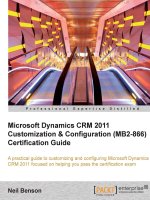

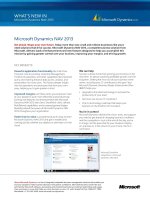
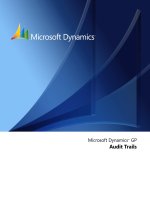
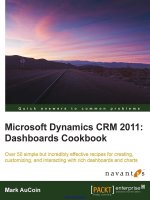
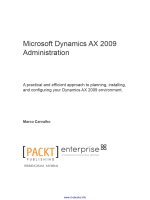
![maximizing your sales with microsoft dynamics crm 2011 [electronic resource]](https://media.store123doc.com/images/document/14/y/ir/medium_irp1401358930.jpg)

